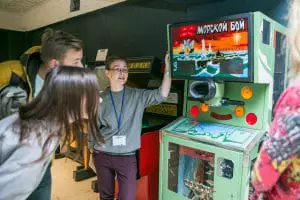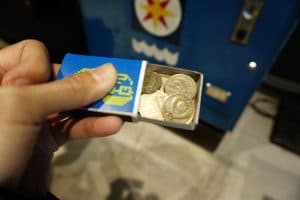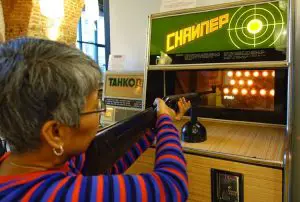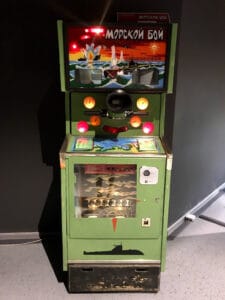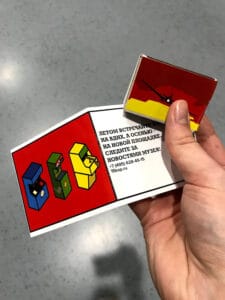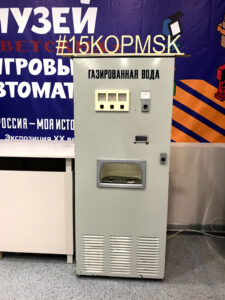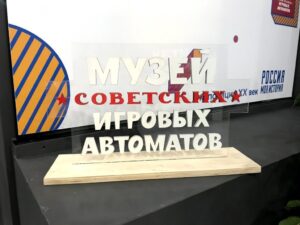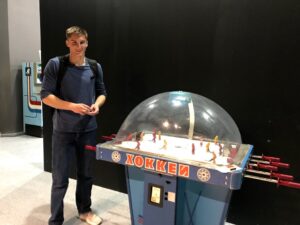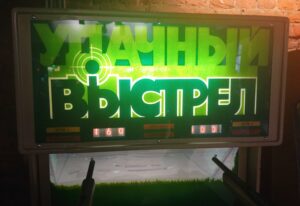The Museum of Soviet Arcade Games (Музей советских игровых автоматов) is a private museum founded by friends Alexander Stakhanov, Alexander Vugman, and Maxim Pinigin in 2007. Initially this was just thier hobby and they made the restored and working games open only by reservation on Wednesdays. However, the games proved wildly popular. Eventually, they had to found an organization to coordinate and house their activities. The Museum of Soviet Arcade Games has since expanded to two branches – one in Moscow and one in St. Petersburg, and boasts over 50 machines in each location.
A Brief History of The Museum of Soviet Arcade Games
At first, the trio simply wanted to find a functioning Sea Battle (Морской бой; a classic Soviet arcade game) unit for their apartment. Although they searched everywhere, from abandoned pioneer camps and cultural centers to cinemas and parks, they only found non-functioning machines. After rescuing a few of these that were destined for a landfill, the friends set up a repair shop in Pinigin’s grandfather’s garage and scoured the former Soviet Union for more parts.
During their travels, they met people from all ages and backgrounds that shared their nostalgia for Soviet games. They also learned that following the dissolution of the Soviet Union, many of the machines were gutted to repurpose their parts–few, if any, intact machines remained. Further still, the machines were primarily produced by military facilities otherwise engaged in manufacturing electronics for nuclear testing and weapons, largely because these facilities were among the only places at the time with the capacity to engineer them. This meant that, as the Soviet Union fell in 1991, many of the manuals were destroyed; the facilities dumped nearly all their documents to prevent them from falling into the wrong hands in the power vacuum that followed. Although the CIA was prevented from stealing Soviet arcade secrets, this has caused a major headache for anyone interested in restoring them.
The group of friends eventually started putting many other machines together, and, having found that there is a demand by other fans to see these restored machines, the trio decided to open their own arcade.
They approached their alma mater, Moscow Polytechnic University, and rented one of the school’s defunct bomb shelters. They opened the first Museum of Soviet Arcade Games there 2007 with 37 arcade machines. They quickly began earning 5,000 rubles (just under $150 at the time) per day.
The museum expanded to St. Petersburg in 2010, opening a branch in the former Rot Front candy factory. “Nowadays,” their website claims, the museum has “over 40 units, including the working ones!” But not all the non-working ones are marked (particularly the rides), so beware of machines that simply eat your money!
Classic Soviet Arcade Games
Every game at The Museum of Soviet Arcade Games costs 15 kopecks to play, and the machines have a mechanism that first weighs the coin, then flips it to test to velocity – only authentic Soviet coins will flip at exactly the right speed, so no counterfeits or modern coins are accepted. Each patron is given a bundle of authentic coins when they pay for admission.
One of the most popular games, Sea Battle, is well-represented in the arcade hall with no fewer than five working units. The player peers through a periscope, as in a submarine, and is given seven torpedoes to sink seven enemy ships. Other popular games include other shooters like Sniper-2 (Снайпер-2), where you are given one minute to successfully hit 30 targets with a light-sensitive rifle. Winter Hunt (Зимняя охота) and Safari (Сафари) both follow a similar premise.
As opposed to many Western games of the same era, the Soviet games tend not to employ fantastical creatures or elaborate gameplay. They’re remarkably simple yet deceptively difficult. The games, designed to develop hand-eye coordination, strength, reaction speed, and logical, focused thinking, were influenced by military training to produce more militarily adept citizens. In the spirit of Marxist ideology, the games were not programmed to include a high-score list. If you completed the game successfully, you were simply rewarded with a free game.
Games are distributed across two stories at the Moscow Museum of Soviet Arcade Games, with many of the most iconic on the ground floor. Upstairs, you can also find classics such as Basketball (Баскетбол), in which you press buttons that correspond with numbered air holes to shoot your “basketball” (a ping pong ball) in your enemy’s net.
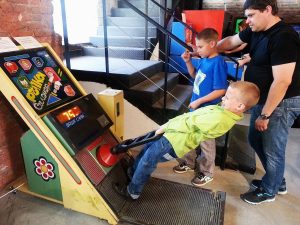
You’ll also find games based on Russian culture. Gorodki (Городки) is an ancient Russian game. It’s arcade version requires you to fling electronic sticks at moving structures. Turnip (Репка) is classic strength tester based on a famous Russian nursery rhyme. Hidden in an inconspicuous corner we found a game not unlike streetfighter that featured at cat. Although the cat was adorable (and one of the only non-humanoid protagonists in the arcade) the game was almost impossible.
In total, of the 90 different Soviet arcade games that were ever produced, the museum claims to have found about two-thirds. Some are still waiting to be fixed. As far as one of my personal favorites, Sniper-2, is concerned, the museum claims to own 85 percent of the world’s remaining supply of the discontinued light bulbs that make the game work. Despite their scarcity, however, the games are left in the open for everyone to play and enjoy – not admired from behind glass windows.
On the cool, rainy Saturday evening a friend and I stopped by the Moscow location, we found children and adults from across the spectrum playing the games: parents with small children, teenagers on dates, other foreigners and working professionals out with their friends. The museum draws on nostalgia from the older generation and curiosity from the younger, creating as close to an authentic Soviet arcade experience as you’ll ever find.
Katheryn Weaver
A Trip to the Moscow Location
Our last program excursion for our Moscow study abroad experience with SRAS took us back to VDNKh park, where we had enjoyed the Russia Day festivities a month before. The Museum of Soviet Arcade Machine is a small, out-of-the-way nook located on the first floor of one of the park’s several famous pavilions. Museum attendance was sparse that day, meaning the exhibit was a beacon of color and sound in an otherwise silent and dreary space.
We were handed out tickets, along with a small match box filled with small 15-kopek coins, before our guide took us through the three rooms of machines, pointing out the most notable of their collection. She made sure to note that, while we were allowed to keep the match boxes as a souvenir, all coins had to remain within the exhibit. They are no longer in mint and therefore in limited supply. However, she mentioned that the coins are found all over the world, meaning many guests obviously do not listen. While amusing for us, the museum takes a much dimmer view, as they have to buy them back.
The first machine spotlighted on our tour of The Museum of Soviet Arcade Games was a pinball machine called “Спорт” (Sport). Although the game is one of the most popular arcade games worldwide, the machine was unfortunately out of commission, having broken the previous day. The exhibit included two machines of the most famous Soviet arcade game – Морской бой, or Sea Battle. This game and others used mirrors to provide the illusion that the user is, for example, shooting ships on the horizon of a vast sea. In reality, the waves ran down the middle of the machine while a mirror reflected the image horizontally so the ships appeared to sail on the sea.
Before we were released to try the games out for ourselves, our guide brought us to a group of machines lining the wall across from the exhibit. While not games, these machines still provide insight into Soviet life in the 1950s and 60s. For example, one machine similar to a phone booth provided information about transportation, including timetables for various metro lines. Next to it was a large block of metal that resembled a cross between a refrigerator and a school locker provided sparkling water for a small price. When the machine was in use, a single cup would be placed under the dispenser. Users would pay, drink out of the cup, and then place it upside down to be washed for the next person to use. Hygiene aside, I found myself wondering how often the cups were stolen by pranking teenagers.
I then broke off from my small group to try out Морской бой (Sea Battle). It took me longer than I’m willing to admit to actually figure out how the game functioned, but after a trial run, I managed to shoot down a small number of enemy ships. I stuck to similar shooting games for the rest of our time there with mixed success. Part of my problem was that I failed to take the time to really figure out how the game worked before I began – there were too many options, sounds, and lights for me to really stop and figure out what I was supposed to be doing. I realized too late that there were detailed instructions above each game in both English and Russian explaining the game’s history and how to play. Overall, I consider the Soviet arcade museum to be the perfect activity for one or two people on a rainy day.
Although I wouldn’t consider the exhibit at The Museum of Soviet Arcade Games large, I still found the number of machines overwhelming, partly because I was with a group. It felt odd to be doing something so individual while out with all of my friends. Many of our group felt the same, as we trended towards the two player games or otherwise traveled in small groups, taking turns figuring out the various games. I started out playing a hockey-themed version of foosball with my classmate Mitch, who beat me soundly. He gave me a lot of credit for his win, however, as I scored most of his goals for him. We then traveled over to watch Paul repeatedly beat Mason at basketball before I gave it a try. While Paul still won, I managed to block all but two of his shots. I unfortunately proved to be no good at actually scoring.
Helen McHenry
Visting the St. Petersburg Location
Maybe you’ve heard of Pacman, Donkey Kong, and Space Invaders, but what about Rally Авторалли-М), The Humpbacked Horse (Конек Горбунок), and Torpedo Attack (Торпед Атака)? While Americans were shoving quarters into arcade machines to play game after game, those in the Soviet Union were dropping in 15 kopecks in just the same way.
A few friends and I learned about The Museum of Soviet Arcade Games (Музей советских игровых автоматов) from a list of suggested things to do that we got as part of our study abroad experience in St. Petersburg. list and decided to try out the Soviet arcade experience. Once you enter the place, ‘museum’ seems to be bit of a misnomer for it. When we visited, there was rocking retro music, two boys yelling in excitement about the latest score in their foosball (table soccer/football) game, and a man getting frustrated with another ‘game over’. This is no normal museum. While a museum-goer could, in theory, just look at the machines and read the information (available in both Russian and English), I simply wouldn’t advise missing out on playing the games. With admission comes a small box of 15 kopeck pieces so visitors can get a first-hand experience playing these games.
The Soviet arcade games range from big-game hunting and commanding a naval fleet to hockey, racing, and horseback riding. There were plenty of game types to choose from: standing digital arcade machines, foosball-esque table games, and pinball. We jumped from game to game. Some, such as The Humpbacked Horse, are single-player games; in this one, you control a boy and his steed jumping over obstacles and fighting back nasty wolves. Our favorite game was simply titled hockey (Хоккей). In this two-player table game, each player controls 5 players and a goalie. Each player moves back and forth with the handles and then spins around by spinning the knob. This game proved to be just as challenging as it was fun, as we spun our skaters around and around to try to slap the ‘puck’ (a small ball) into the net.
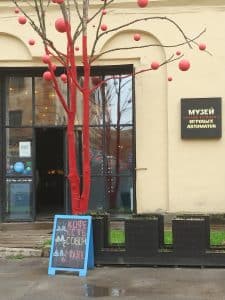
The games were just a part of what turned out to be a happening place at The Museum of Soviet Arcade Games. There was also a ping-pong table, chess boards, a good-sized seating area with cartoons being shown, retro kvass and soda water machines, and a full cafe. There were also plenty of people just hanging out on their laptops or doing school work. The museum’s website has great in-depth information on all of the machines, including pictures of the machines being repaired and some recreations of the games that you can play at home.
The Museum of Soviet Arcade Games turned out to be much, much more than just a museum. It was a retro arcade hangout, and I will certainly be visiting again during my time in St. Petersburg. Gamers and other competitive people will love this museum tucked away in the center of St. Petersburg.
James Taylor



